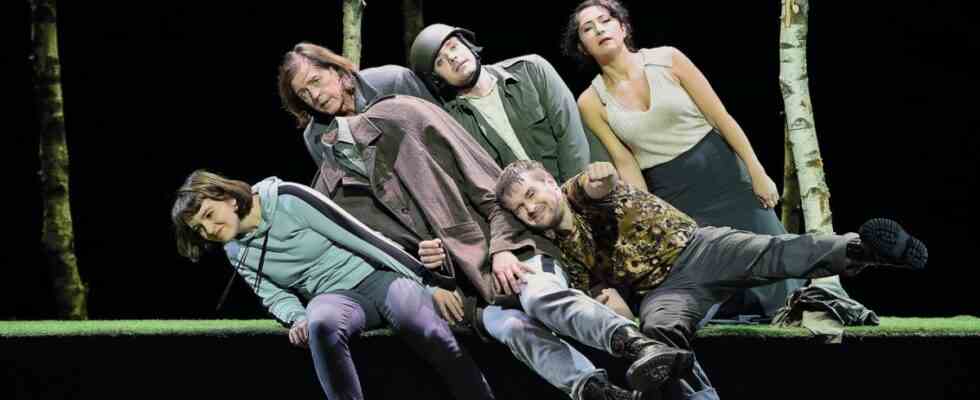How do you play war on stage? How do you play a girl in war, blood, guns, mutilated bodies? And, the question must be allowed: If you play it, what effect does it have? The evening in Bamberg, there is no other way to put it, flies in your face at the end. Alina Rank is standing at the stage ramp and calmly speaking the epilogue that the Ukrainian author Natalia Vorozhbyt wrote for the ETA Hoffmann Theater there. What has art contributed to saving the world, she asks in it. You, the artist, whose piece was on view. It is no consolation for her that her texts will continue to exist if she dies in the war. “I want to stay in their place,” she writes. “Please.”
Vorozhbyt’s play “Destructed Streets” had its premiere at the Bamberg Theater on Friday. At least in Bavaria it is an evening that is unrivaled in its political relevance. No particular interests, no navel-gazing, this is about the war in Ukraine, about how we deal with it – also artistically – and about the glaring despair that the military attack keeps going on and on. The staging does not rely on dismay, but – as a hard, even brutal counter cut – on comedy and the grotesque. Because anyone who has experienced his sympathy in the theater is all too easily released from the hall. Director Wojtek Klemm does not go down this path. A wise decision.
For her play, the author traveled to the war zone
Natalia Vorozhbyt wrote her play – originally titled “Bad Roads” – on behalf of the Royal Court Theater in London. It premiered there in 2017, and Vorozhbyt made an excellent film out of it. To do this, the author drove to the war zone in the Donbass, incorporated her research, developed six images with very different perspectives, which she interwoven: A teacher who gets caught in a roadside check and is harassed. Girls waiting for soldiers in the evening. A woman who runs over a chicken and is put under tormenting pressure by the farmers. Another woman accompanying her lover; he is dead, his head cut off and gone. A soldier who abuses a girl in a basement.
How do you play a girl at war? Jeanne Le Moign shows it, wrapping a few hairs around her finger. Can you play war at all?
(Photo: Martin Kaufhold)
For Bamberg, Vorozhbyt added an epilogue that anchors the piece in today. She writes about her situation in Kyiv, laconically interweaving everyday life and war. Drone attacks stand next to home renovations, bombs next to curtain rods. In between, the bitter despair that art won’t save the world. The cut goes deep. The war brought death, destruction and suffering. What can now be felt directly in the theater and not just indirectly through images and reports: the war also destroys culture, takes away faith and values. At least art can make this loss visible. At least that evening in Bamberg.
Director Klemm has largely given up realism and linear narration. Romy Rexheuser’s stage resembles an extinct wasteland. A few birch trunks dangle above the ground, a kind of bunker opening sunk into the ground on the right, war material on the left. The actors are delivered to this surface. At first, they are jerked by uncontrolled movements, as if their bodies were processing trauma. Finally, Marek Egert goes to the microphone and talks about a gas bill for 1,551 euros, which is ruining his plan to buy the new iPhone. Robert Knorr says he just advertised a spicy fast food dish. Because he could cry such beautiful tears, he was just right in the piece. More autofictional elements follow, the thrust is clear: like the author, the director intertwines everyday life and war, the Western European, largely undisturbed standard of living with Vorozhbyt’s pictures.
On the verge of tastelessness
This is close to the border of tasteless, but ultimately reflects a reality. What’s more, this counter cut works so well because there’s an impressive ensemble on stage. In this way, they switch smoothly from the grotesque to the individual images of “Destructed Streets”. For example, the transport of the headless dead man rocks the six performers across the stage with the really nasty mixture of comedy and desperation. Between Jeanne Le Moign as a lover and Eric Wehlan as a soldier is Robert Knorr as a dead man, his head buried in a jacket. As in an 1980s comedy, the dead man’s hands slide here and there onto a knee. Then again, Le Moign and Wehlan face each other, desperately touching each other and yet not finding the right way to feel anything.
Even if the evening overwinds at some points, Stephan Ullrich’s lovingly marked chicken runs across the scene once too often: he tells in an unbelievable density of war, loss, the limits of art and of us. That won’t save the world, but probably not much more is possible.

